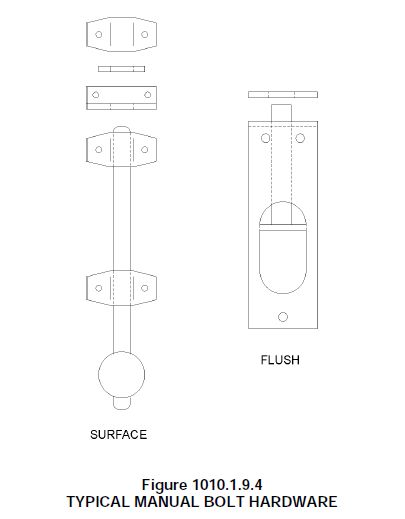This is a great question. I’ve had several situations where an AHJ interpreted the term “bolt lock,” used in the International Building Code (IBC), to mean a deadbolt. Like so many code issues, reading the code without digging deeper can result in mixed interpretations. The IBC says this:
“1010.1.9.4 Bolt locks. Manually operated flush bolts or surface bolts are not permitted.”
But what’s a bolt lock? It’s tough to tell from this single line – especially if you’re not familiar with the terms “flush bolts” or “surface bolts” which are so commonly used in the hardware industry. In this section, the IBC is referring to flush bolts and surface bolts that are installed on the inactive leaf of a pair of doors. It is not referring to deadbolts. My interpretation* is based on the following:
 a) There are 5 exceptions listed under this section. Four of them specifically reference edge-mounted or surface-mounted bolts on the inactive leaf of a pair of doors. The exception that does not include this text is, “On doors not required for egress in individual dwelling units or sleeping units,” which could be interpreted various ways but doesn’t have much impact since the doors are not required for egress.
a) There are 5 exceptions listed under this section. Four of them specifically reference edge-mounted or surface-mounted bolts on the inactive leaf of a pair of doors. The exception that does not include this text is, “On doors not required for egress in individual dwelling units or sleeping units,” which could be interpreted various ways but doesn’t have much impact since the doors are not required for egress.
b) In the IBC Commentary, Figure 1010.1.9.4 is called Typical Manual Bolt Hardware, and illustrates a surface bolt and a flush bolt that would be used on the inactive leaf of a pair of doors. The graphic does not show a deadbolt.
c) The IBC Commentary for this section refers to the inactive leaf of a pair of doors multiple times. A deadbolt would not typically be mounted on the inactive leaf of a pair (except maybe in a Fixed-it Friday application).
So – manual flush bolts and surface bolts are prohibited on egress doors, with some exceptions (covered in my next Decoded article). But what about deadbolts?
In my opinion, deadbolts are acceptable on a door in a means of egress if the following criteria are met:
- The door must not be serving a space that requires panic hardware (except where key-operated locks are allowed).
- The door must be able to be unlatched with one operation (except residential dwelling units and sleeping units), which means that the deadbolt must be the only lock/latch on the door, or the deadbolt must be part of a mortise lock or interconnected lock where turning the lever will retract both the latchbolt and the deadbolt.
- The deadbolt (thumbturn) must be operable from the egress side with no tight grasping, pinching, or twisting of the wrist.
- The deadbolt must be mounted between 34 inches and 48 inches above the floor.
If the door and hardware meet these requirements, the opening is compliant with the IBC’s requirements for operable hardware.
*As you know, I’m not the AHJ who is responsible for interpreting and enforcing the codes, so the AHJ responsible for your project may have a different interpretation.
Graphic: 2015 International Building Code Commentary
~~~
For more information about flush bolts, check out this video!
You need to login or register to bookmark/favorite this content.





“Dead Bolts – How To Live With Them” Sounds like the next white board topic.
An additional criteria (criterion – singular) for the acceptability of deadbolts on doors in the Means of Egress is “the unlatching of any door or leaf shall not require more than one operation.” (2012 IBC 1008.1.9.5 Unlatching) A deadbolt + a lever handle that are not integrated would involve two operations and would not be compliant.
That’s #2 – The deadbolt must be the only lock/latch on the door (except residential dwelling units and sleeping units). Maybe I should add to that statement to clarify?
– Lori
Agree. Multiple actions to operate the exit door will increse the egress time
Perhaps add a qualifying sentence to #2 acknowledging the acceptability of interconnected and mortise locks that incorporate a deadbolt?
I have used automatic flush bolts on the inactive leaf and that has been a good solution. If the egress is high traffic ill go with vertical rods on both active and inactive. Inset panic releases are a great option if the budget can handle it. But by this time folks are going ouch